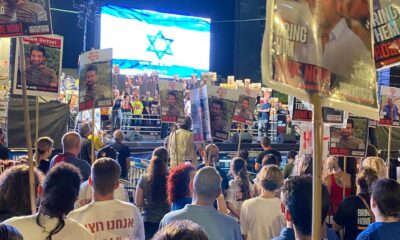
OpEds

Captives of conflict: hostage dynamics in modern warfare
Taking hostages is an age-old military practice that stretches back for as long as humans have engaged in warfare.
Hostages served strategic and political purposes in medieval warfare, where they could be used to exert pressure and force compliance or help negotiate favourable terms. In a practice that has long been discontinued, both sides could occasionally offer up their own as hostages to ensure that treaty terms were complied with. Then, there was the quaint practice of taking hostages to guarantee ransom payments or meet certain obligations. It could range from acts of pure defiance or intimidation to securing a potential ally or political alliance. In medieval warfare, hostages were often viewed as necessary and pragmatic. Centuries later, one would have thought that the barbaric act of taking hostages for leverage was out of place in sophisticated modern society.
Unfortunately, the seizing of hostages is all too prevalent in modern times, although the context and the dynamics may have changed. Criminal gangs and terrorists make good use of hostages for political, ideological, or financial goals. Modern warfare must factor in the doctrine of dealing with hostage scenarios through complex diplomatic negotiations, intelligence operations, military interventions, and humanitarian initiatives. All the odds are stacked with the hostage takers, as no matter what the outcome, their nihilistic purposes are usually fulfilled. The terrorist organisation can gain much capital through the collateral damage suffered by the surrounding civilian population during efforts to release the hostages. The tragic death of hostages during attempts to free them can also benefit terrorists.
Due to the “hostage exchanges” that have taken place between Israel and Hamas, it’s necessary to define the term “hostage”. The fact is that Israel has mainly exchanged criminals or prisoners for Israeli hostages in spite of the world press depicting these exchanges as a “hostage exchange”. There’s a vast difference between an incarcerated criminal, a prisoner of war (POW), and a hostage. POWs are typically captured during armed conflict during hostilities, and are members of a recognised armed force. They are entitled to certain legal protections under international humanitarian law, including humane treatment, protection from violence, and the right to be repatriated at the end of hostilities. An incarcerated criminal has been detained after a fair trial and is subject to fair and humane treatment under the law. Hostages are unlawfully seized or detained for political, strategic, or ransom purposes. Unlike POWs, hostages aren’t necessarily combatants, and their capture violates international law.
Hamas has labelled the Israeli practice of incarcerating those who have committed acts of terror or serious public disturbances after the due judicial process as “hostage-taking”. The recent hostage exchanges involving those Israelis kidnapped on 7 October 2023 have resulted in the release of thousands of convicted Palestinian criminals for a hundred or so Israelis that Hamas holds illegally. No stretch of the imagination can find equivalency in the methods that both sides have used to detain their prisoners, nor the culpability of those detained. Besides the small number of members of the Israel Defense Forces (IDF) captured on 7 October, most of the hostages are innocent civilians. The same cannot be said of the criminals, ranging from murderers, maimers, and insurrectionists that the Israelis have been forced to release.
Taking hostages is a powerful weapon in asymmetrical situations. The IDF possesses a huge advantage over Hamas in terms of fighting power and firepower. Hamas uses its Palestinian civilian population as human shields – a form of hostage in combat situations – to curb Israeli fire power. Using civilians and Israeli hostages to diminish the IDF’s fighting power is a highly effective means of curtailing Israeli ground and air operations. Every civilian death is a propaganda victory for Hamas, as the IDF must go to extraordinary lengths to limit collateral damage and ensure that the Israeli hostages come to no harm. Circumstances have required the IDF, attempting to at least free some of the hostages, to conduct its operations around enforced ceasefires, which favour Hamas.
Urban warfare, war at its most nightmarish, has gained precedence in the 21st century. The urban environment, which heavily favours the defender, has become the refuge of the weaker force. The use of civilians as human shields and the taking of hostages act as powerful force multipliers for the weaker side in asymmetrical warfare. Modern warfare demands that modern armies adapt to the new normal, and build a doctrine to neutralise a determined and ruthless enemy in the urban environment. New technology such as drones and guided munitions will be used to gather intelligence and to direct fire more accurately to limit collateral damage. The new urban warfare doctrine must include ever higher levels of combined and joint arms operations. The dissemination of information surrounding the conduct of the operation demands the utmost professionalism to produce a fit-for-public product with full co-operation with those conducting the operations. The Israeli information efforts have been amateurish at best, and downright harmful at worst. The propaganda war has assumed a new significance and heavily favours the “victim” or “weaker side”.
The tragedy of this conflict is that Hamas can even use dead hostages as bargaining chips. Common sense demands that one should never negotiate with terrorists, as this will encourage similar behaviour in the future. However, it’s impossible to ignore the plight of hundreds of Israeli hostages, allowing the whole process to become one of damage control and choosing the unpleasant path of least havoc.
- Dr David Brock Katz is a research fellow at Stellenbosch University in the faculty of military science. He has published three books and numerous academic articles dealing with aspects of South African military history and military doctrine.










